Sometime in the mid-to-late 1970’s, one of my uncles had a Triumph TR-7. I recall the TV commercials touted it as “the shape of things to come”. It’s outline was fairly radical. While other cars of the era were as big as a battleship, the TR-7 was notable because it seemed so small.
When my dad saw the car at a family gathering, he wasn’t too impressed. Parked next to his enormous Lincoln Continental, the little TR-7 looked about like a Matchbox car. Of course, my uncle did not pay any mind to my dad. They were separated by quite a few years in age, so there was definitely a generation gap.
Me, on the other hand, thought that little speedster was about as cool as could be. To my eye, it looked very bit like a space fighter, inside and out.
After a while, my dad drifted back into Grandma’s house. My uncle grinned at me. “You want to go for a ride?”
He didn’t have to ask twice.
Oddly Shaped. Easily Built.
As sleek and angular as that TR-7 was, the B-Wing Fighter is almost the polar opposite. Each element is sleek in and of itself, yet put it all together, and it is the definite oddball in a universe of very odd things. Yet I think it is that very oddness that causes it to be viewed with such affection.
I’d built up the cockpit and engine section previously. All that was left were the vertical and horizontal wings, and the various guns, tubes, and other detail bits.
As with the previous sub-assembly, I decided to just build it like a kid, priming and painting the parts before assembly. The horizontal wings can be almost fully assembled, only the gun bits at the ends of the wings being left off to make painting easier.
The lower, vertical wing was left unassembled, as putting it together would have required a bit of masking – something I was trying to avoid for simplicity’s sake.
The blue bits were primed in white, as I wanted a nice bright undertone for them. The white parts were primed in a light gray. This would help me see where the white paint was going later on down the road. The gray parts were imaginatively primed in gray. 🙂 Badger’s Stynylrez primers were used for each color.
Adding Some Paint
I started with the white paint. My preference when painting multiple colors in one session is to go from lighter to darker. For the white, I used my homemade bottle of Spaceship White, which is a bottle of Tamiya XF-2 White, with a few drops of XF-55 Deck Tan, and XF-19 Sky Gray added in. It allows for later white highlights if desired, and also imparts a bit of a highly desaturated look, yet retaining (at least to my eye) some brightness. I misted this color on in two sessions, allowing my eyes to rest for a few minutes to avoid “snow blindness”. Doing this helps to make sure everything is all white, without too many patches of gray showing through.
The blue parts were painted with Vallejo Model Air’s Azure BLue, which is one of my favorite colors ever. Normally used on RAF Desert Air Force aircraft from WWII, I really liked how it presented itself on the B-Wing Fighter. It’s bright, yet not too saturated. I felt it would work well with the orange decals to later be applied.
Gray parts were painted with Vallejo Mecha Color Phantom Gray, which is very similar to Tamiya’s XF-63 German Gray.
Get Yourself Together!
Once the paint had time to fully dry, I assembled the remaining parts. Being Bandai, fit was no problem. I’d already made the decision that the seam lines resulting from painting then assembling would be treated as panel lines in the weathering process. Doing so is probably a bit lazy on my part… but remember – the focus is fun. Doing it this way was fun for me. 😉
The horizontal wings can be moved up and down, the pivot point coming in the form of a clear rod. Pay careful attention to how this is inserted, because once in, it does not want to come out. Each rod has a groove in one side, which corresponds with a tab at the forward point of insertion. One end of each rod also has a notched tab for a later part to fit over – make sure that goes forward.
The left wing went on with little drama. I set it in place, holding the engine section and the wing together in one hand, and with the other hand I inserted the clear rod. It went straight in – no resistance. Perfect.
The right wing, on the other hand, had other ideas.
Following the same procedure, I began to push the rod into the provided holes. Almost immediately it met with resistance. I tried the brute force method, and pushed harder… only to be met with the rod starting to flex. I quickly backed off the pressure, removed the rod (which took a bit of effort) and examined it.
Everything looked OK, but I assumed that one of the holes was not aligned properly. I tried again, but this time I gently moved the wing around a bit, looking for the right spot for things to align. The trick proved to be lowering the wing just a bit. Once the rod got through the first slot, it aligned everything else afterwards, and the part slid right in.
The lower wing assembly is simple – snap, snap, snap, and it’s done. Perfect fit.
Dekuls, Deecals, and Dehcals
To prepare for the decal process, the entire model was given a gloss coat of Future/Pledge/Kleer.
I’ve found Bandai decals to be of very good quality in terms of adhering to the model, and being reasonably thin. I’ll admit that coming from an aircraft background, I’ve been spoiled by the printing quality of Cartograph decals. Bandai’s efforts are well printed, but they could be improved. Still, for these purposes, they worked perfectly.
The kit features quite a few small stencils. Each was applied with a simple dot of water to settle it on, then squeegeed into place with a cotton bud, and a dot of Solvaset to force good adherence to the model’s surface.
The largest decals were the four orange “roundels”, placed around the model in similar fashion to real world aircraft. Three of the positions were easy enough to apply, going over mostly flat surfaces.
The decal that goes on the upper right wing is broken into three parts, which allows it to fit around and conform to a surface greeblie. The key to getting good fit is to trim the carrier film right up to the edge that aligns with the wing feature. And by right up to it, I mean right up to it – try to leave no carrier film. The sections that go on either side of the bump fit perfectly if trimmed closely.
The third decal part goes on top of the bump. It is a single, straight section, with a three part split on one end. Trim the carrier film here too. When placing the decal. I concentrated on getting the forward part lined up first, and then worked my way back along the wing bump. The split at the end allows the section to cover the top and sides.
The method mostly worked. it took quite a bit of Solvaset to get it all to conform, and even then a few minor touchups were needed with orange paint.
I suppose the proper way to do it would have been to mask and paint, but for the sake of speed and simplicity, I went with the decals.
Coloring In Those Panel Lines
For the panel lines, I used two acrylic products, Citadel’s Nuln Oil Gloss, and Vallejo Weather Effects Petrol Spills, as they perform equally well, and look the same. ( I was running out of the Nuln Oil!)
Unlike enamel or oil washes, these are best applied with some precision. I prefer to use a #0 liner brush. When the gloss product is added over the gloss surface, it generally flows very well, so capillary action takes care of most of the work. However, there are always a few areas that it gets out of place.
Cleaning these up is simple enough. I allowed the product to dry for a few minutes. Then, using a #0 round brush dampened with Vallejo Airbrush Thinner, I “chiseled” at the errant wash. The wash peeled away, almost like onion skin, fairly easily. Working my way around a section at a time, everything was given a panel wash and cleaned up. I wasn’t too worried about absolute cleanup, because with further weathering to come, some of the wash was left in place as initial staining.
I really like this method. The final result looks no different from oil or enamel washes, but because of the speed at which it dries, further steps can be taken within a few hours (or even minutes if you are in a hurry). For the oil and enamel products, wait times can be a day, or even several days, before later applications can be made. The trade-off of technique adjustment is worth it to me for the sake of speed.
Ready For The Gunkiness

Painting and assembling this kit has been quite a bit of fun. It has great surface detail, a cool/weird shape, and of course it fits together perfectly. I think this model will join the A-Wing fighter as my favorites among the “Alphabet Soup” fighters from the Star Wars universe.
I think the only drawback to this model – and it is certainly not Bandai’s faut – is that the shape of the thing makes it a bit awkward to hold and photograph. It stands about 10 inches tall, and on the stand, even higher. I did find that the stand is stable enough to use for painting, decaling, etc. I did add some poster putty around the edges to make sure it was stable. The model can even be positioned at various angles on the stand – quite handy indeed.
The next steps will be applying all the weathering. I plan to really go heavy on it, as I want a beat up, gunked up, stain covered hunk of chipped paint flying through space.
That day at my grandma’s house, I had an absolute blast zipping around the back roads of Colquitt County Georgia in that TR-7 with my uncle. In my mind, I was flying in a spaceship, zipping through the cosmos as deftly as any Star Wars hero. While any other car would have been fun too, the futuristic shape of that particular automobile really made it something special.
I think that is the fun part of the B-Wing… that unusual, unorthodox shape. It is a testament to imagination. Though full of familiar parts, it is all placed together in a truly unique way that I think fully fits the bill as “alien”. If it only exists to highlight the wonderful shapes that can come from the minds we’ve been blessed with, that is enough.
Of course, 10-year-old Jon is also thinking “Yeah, but it also would have been really cool to cruise that thing around grandma’s house!”
It certainly would have turned heads!

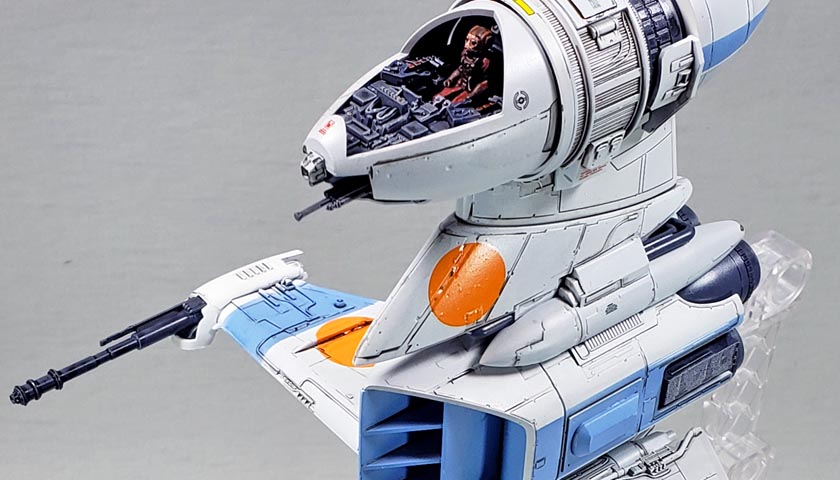
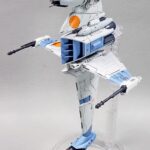
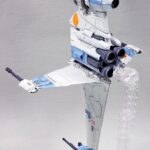

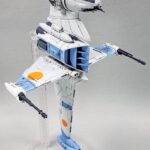
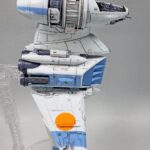
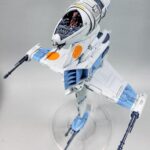

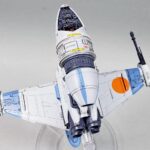

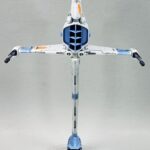
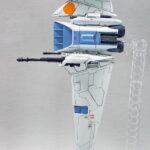

Leave a Reply